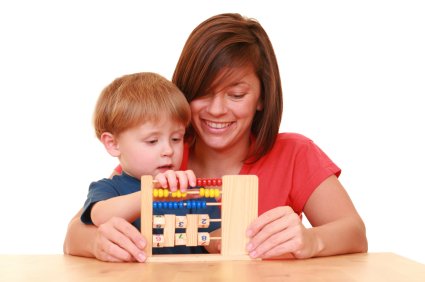by Ann Bowers
 Math skills can start to be developed at a very early age. Here is a quick guide or cheat sheet that home schoolers and parents can use that shows what math skills to work on based on your childs age.
Math skills can start to be developed at a very early age. Here is a quick guide or cheat sheet that home schoolers and parents can use that shows what math skills to work on based on your childs age.
Ages 1-3
- Count to 5.
- Put objects in order by size.
- Sort objects by shape and color.
- Learn the meaning of math vocabulary words, such as: big, small, large, tiny, round, etc.
- Learn to respond to math vocabulary commands such as: “Give me some pennies.” “Give me more pennies.” “Give me fewer pennies.” “Put the penny (in, above, below, beside, inside, outside, underneath, over) the glass.” “Put the penny between the glasses.”
- Learn concepts about volume by playing with rice or sand and various kinds of containers.
- Learn concepts about volume by playing with water and various kinds of containers.
Ages 3-5
- Count to 10, then 25.
- Learn to match objects one to one (one to one correspondence).
- Learn the names of a circle, square, triangle, and rectangle.
- Sort objects by shape and color.
- Put objects in order by height.
- Learn to recognize a penny and a dime.
- Learn to recognize numbers from 1 to 10, then up to 25 (use flashcards).
- Learn to write numbers 1-12 starting at age 5. (Some children have trouble with 2, 3, 8, and 9 and may reverse them for a while. This is normal.)
- Learn to match the correct number of objects to numbers up to 12.
- Learn to respond to math commands, such as: “Put the penny (in front of, behind) the cup.” “Put some water in this bowl. Put less water in this bowl.” “Put more water in this bowl.” “Put the string around the cup.” “Put the penny first in line. Put the dime second in line.” “Put the pennies first and second in line. Put the dime third.” Put the pennies first, second, and third. Now put the dime fourth.” “Point to the second (or sixth, or eighth, or tenth) penny (in a line).”
- Learn concepts about volume by playing with rice or sand and various kinds of containers.
- Learn concepts about volume by playing with water and various kinds of containers.
- Pick a shape that is different out from a group of other shapes.
- Pick all the shapes that are the same out from a group of shapes.
- Pick a number that is different out from a group of other numbers.
- Pick all the numbers that are the same out from a group of numbers.
- Find “hidden pictures” in a background picture.
- Find your way through a maze (on paper).
- Create a simple pattern using two or more colors.
- Create a pattern using two colors and one or two shapes.
Ages 5-7
- Learn to count to 100, then 500.
- Learn to count backwards from 10 to 1, then 20 to 1.
- Learn to “count on,” i.e.; give the child a number and he or she must count on from that number. For example: Give “33.” The child should say, 34, 35, 36, 37, etc.
- Learn the concept, name, and symbol for 0.
- Learn to write numbers 0-100.
- Learn to recognize number names (printed) 0 to ten.
- Learn the signs: plus (add) minus (take away, subtract), and equals (equal to, equal).
- Learn to add numbers to 10, then 20 using manipulatives. Later, memorize the facts.
- Learn to subtract numbers from 10, then 20 using manipulatives. Later, memorize the facts.
- Learn to skip count by 10s and 5s. (5, 10, 15, 20, 25, 30, 35, 40, 45, 50, 55, 60, etc.)
- Learn to solve simple word problems up to 20.
- Learn the sign X (i.e.; times).
- Learn to multiply numbers: 2s, 1s, 10s, 5s, 0s (in that order) using manipulatives.
- Learn place value for ones and tens.
- Learn to recognize the nickel, quarter, half dollar, dollar bill.
- Learn the worth of each coin and bill.
- Learn to add money.
- Learn the names of the hour, minute, and second hands on a clock.
- Learn how many minutes in an hour, half, and quarter hour.
- Learn to tell time on a manual (not digital) clock.
- Learn to solve simple word problems about money.
- Learn to solve simple word problems about time.
- Learn fractions: one-half.
Ages 8-11
- Learn to count to 1,000.
- Learn to skip count by 2s, 3s, 100s, and 1,000s.
- Learn place value for tens, hundreds, thousands, ten-thousands, etc.
- Learn to add numbers in two, then three, four, and five places (i.e.; 25, 693, 3,089), without carrying over (regrouping) and then with carrying over (regrouping).
- Learn to subtract numbers in two, then three, four, and five places (i.e.; 42, 978, 1576), without borrowing (regrouping) and then with borrowing (regrouping).
- Learn the multiplication tables 0-12 using manipulatives.
- Memorize the multiplication tables.
- Learn to divide using manipulatives.
- Learn the signs for division.
- Learn to divide using the multiplication tables. For example: 6 X 8 = 48. 48 / 8 = 6 and 48 / 6 = 8
- Learn to subtract money.
- Learn to make change.
- Learn to solve word problems about money.
- Learn to solve word problems about time, including days, months, and years.
- Learn measurement (English/American and metric): linear.
- Learn fractions: all types, adding, subtracting, multiplying, and dividing.
- Learn decimals.
- Learn simple percentages: 10%, 50%, 25%.
Ages 12-13
- Continue learning fractions.
- Continue learning decimals.
- Learn percentages.
- Learn measurement (English/American and metric): volume.
- Begin simple algebra.
- Begin simple geometry.
- Learn to solve word problems with two or three steps.
Ages 14-18
- Algebra
- Geometry
- Trigonometry
- Learn to solve word problems with many steps.
- Calculus
- Consumer Math (Computing interest, tax, comparing prices, etc.).
Ann Bowers has been an elementary school teacher, in kindergarten through 8th grade, for 20 years. She was a Bilingual Education Grant Project Coordinator for seven years and a school principal for seven. She has a B.A. in English, an M.A. in Education, and holds California Life Teaching Credentials and specialist credentials in Remedial Reading and Teaching English as a Second Language. She is retired and has started a second career as a freelance writer.
No part of this article may be copied or reproduced in any form without the express permission of More4Kids Inc © 2007










[…] Bowers presents Homeschooling-Math Concepts and Skills By Age. Find out what math skills are appropriate for each age […]
[…] Lilting House. She includes a short excerpt from each article—a nice touch! Math highlight: Math Concepts and Skills by Age A handy list for parents wanting to unschool math in the early […]
Excellent resource!